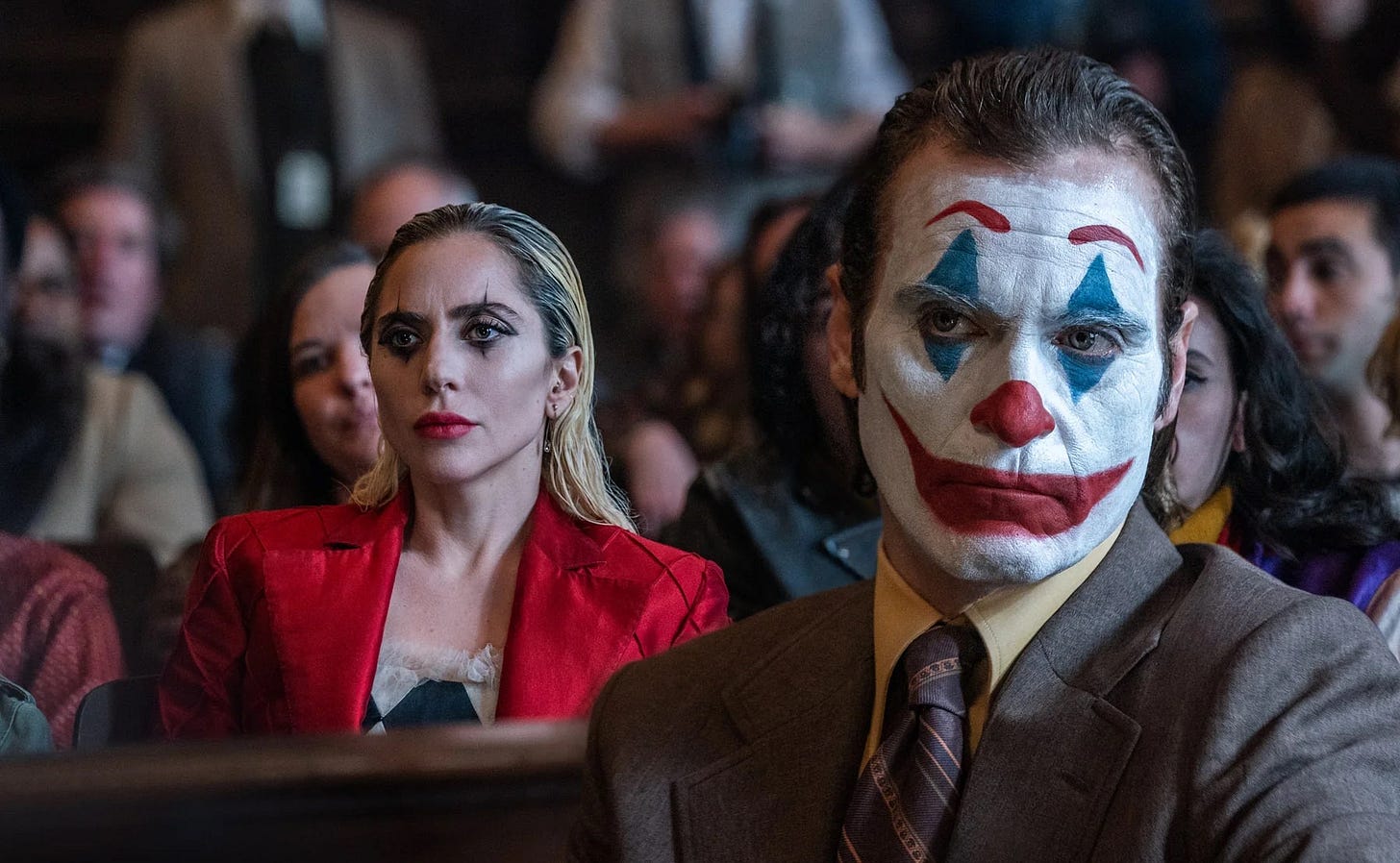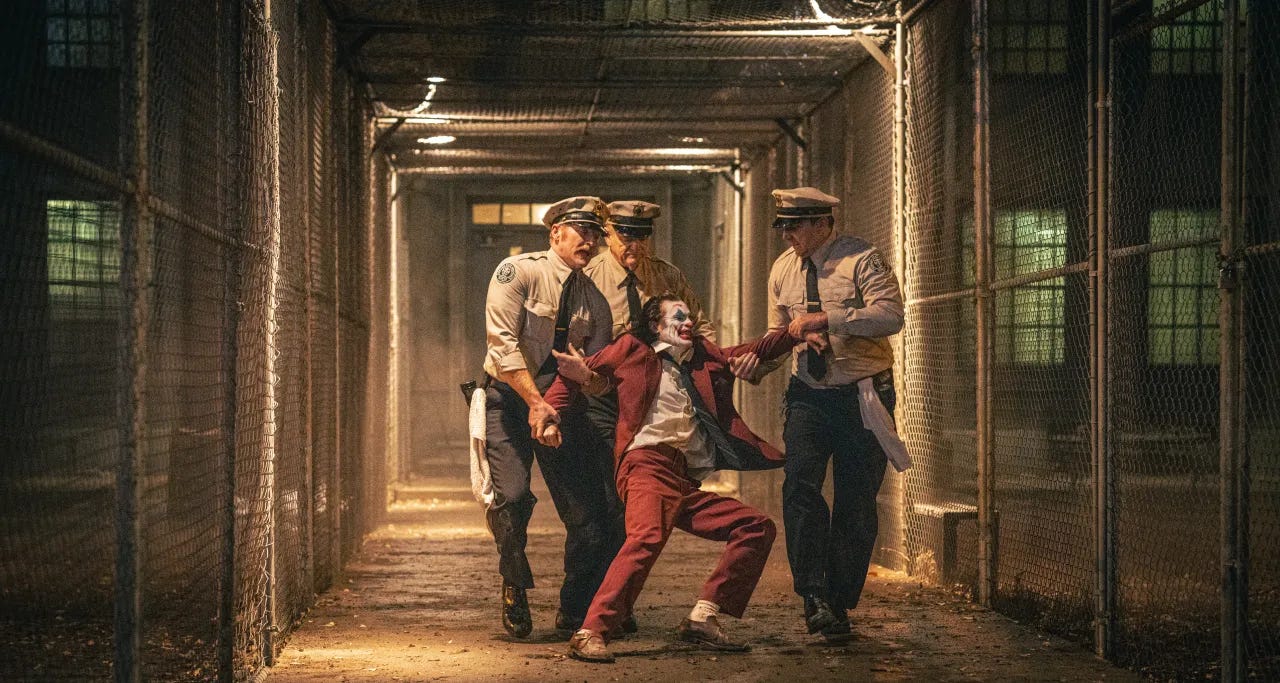Welcome to Girl Culture, the newsletter where Caroline Siede examines pop culture, feminism, and more. You can learn about Girl Culture’s mission here and support here.
The late, great musical theater titan Stephen Sondheim once wrote, “You gotta get a gimmick / If you wanna get applause.” And that’s exactly what Todd Phillips did with his 2019 film, Joker. Like Patrick Willems’ “What if Wes Anderson Directed X-Men?” sketch or SNL’s Black Widow rom-com trailer, Phillips gave us a Joker origin story in the form of a Martin Scorsese homage—a genre experiment that was fun enough until it got way too bogged down in self-serious self-importance. (Not that it stopped it from earning $1 billion and 11 Oscar nominations.)
For his new sequel, Joker: Folie à Deux, Phillips has switched up the gimmick from ripping off Scorsese to ripping off Rob Marshall’s Chicago—complete with Lady Gaga as the Velma Kelly figure to Joaquin Phoenix’s Roxie Hart. To Phillips’ credit, it’s just about the only premise that could’ve gotten me excited for a second round of Joker. And, for a while at least, it’s enough to keep the film bright, lively, and a little bit unique. Unfortunately, this new gimmick soon succumbs to the same self-seriousness that dragged down the original.
Folie à Deux works best as a romance between Phoenix’s disturbed comedian Arthur Fleck and Gaga’s equally unhinged Harleen “Lee” Quinzel, who he meets at a singing group at Arkham State Hospital. While Arthur’s prison days were once grey and rainy, they (literally) turn sunny once he’s met Lee. He gets a spring in his step and a song in his heart that eventually manifests as increasingly elaborate fantasy musical numbers.
It's a pretty basic use of the movie musical format (a love so intense you have to sing about it!) and the musical numbers always feel like they’re about 25 percent away from reaching their full potential. But it’s engaging enough to watch Phoenix casually croon out “For Once In My Life” in the prison rec room or see an escape attempt become a Fred and Ginger-style waltz set to Gaga’s rendition of the Sweet Charity classic “If My Friends Could See Me Now.”
Of course, musical numbers in superhero properties are nothing new. Earlier this summer, Deadpool & Wolverine opened with an NSYNC dance sequence, while Captain America has a great USO number; Birds of Prey gave Margot Robbie a Marilyn Monroe homage; Spider-Man 3 has its infamous dance scene; and Supergirl and The Flash did a whole musical crossover episode that I still revisit all the time. But Folie à Deux commits to the bit to an impressive degree, with some evocative visuals courtesy of cinematographer Lawrence Sher.
While the contrast between Arthur’s grim prison reality and his musical fantasy escapism is straight out of the Chicago playbook, Folie à Deux brings a different energy to the proceedings through its choice of music—mostly a mix of Great American Songbook standards and other retro songs that would’ve been popular in the film’s vaguely 1970s setting. There’s a sweet rendition of “Bewitched, Bothered and Bewildered” from Pal Joey and a romantic duet to the Carpenters’ “(They Long to Be) Close to You.” The best, most innovative sequence imagines a moment of tension in Arthur and Lee’s relationship as banter on a Sonny & Cher-esque variety show.
If Folie à Deux were just a demented musical romance, it could’ve been something special in a small-scale, character-driven way. Alas, Phillips is somehow convinced that these Joker movies need to Say Something Important about the state of the world. Thus we get an exhaustively detailed look at Arthur’s “trial of the century” for the murders he committed in the first film—complete with extended sequences where Gaga is barely even a presence.
The movie’s exploration of how modern society turns violent scandal into entertainment is another place where it shamelessly cribs from the Chicago format, although it doesn’t find anything particularly new to say about that well-trod ground. (Arthur doesn’t directly get up and sing “Give ’em the old razzle dazzle,” but it’s close.) Nor does the film justify why the romance-inspired musical fantasy sequences carry over to the courtroom. Even more frustrating is the film’s sincere investment in the question of whether Arthur should be allowed to plead insanity because he might suffer from a split personality disorder that renders the “Joker” as a separate persona he created to cope with his abusive childhood. In other words, not only is Folie à Deux a Chicago rip-off, it’s a Primal Fear rip-off too, with a bit of Moon Knight thrown in for good measure.
That leads Folie à Deux back to the oppressive self-seriousness that dragged down the first film too. Phillips seems to genuinely think he’s doing something important by exploring the “circumstances” that made Arthur who he is—forgetting that the origin of this character is a comic book villain who dresses up as a clown. There’s nothing meaningful to explore in Arthur’s character because he isn’t a cohesive character, he’s a bundle of ticks and quirks designed to impress whoever has decided that the Joker is somehow the new Hamlet; a role every male actor must take on in increasingly showy ways in order to prove their true acting prowess.
By the time the film breezes past an implied prison gang rape scene, it’s clear that Philips is more interested in edgelord shock value than anything else. And, ironically, he’s so deeply obsessed with fleshing out Arthur’s psychological profile that he forgets to give Lee more than a single dimension as a character, which leaves the one interesting strand of the movie feeling hollow by the end too. Rather than a true romance, we get a male-centric character study with a female character on the margins—hardly groundbreaking stuff for the superhero genre, even if they’re singing about it.
Grade: C
Other stuff I’ve worked on lately: I’m currently reviewing Agatha All Along weekly for Episodic Medium. Elsewhere, I weighed in on Zachary Quinto’s new NBC medical procedural Brilliant Minds for The Daily Beast and Sophie Turner’s new jewel thief drama Joan for The A.V. Club. I also shared a Twitter thread about the financial realities of working as a freelance writer these days.







